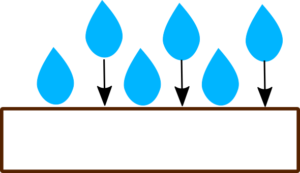Crops transpiration produces water vapour inside greenhouses which need to be dehumidified to maintain suitable humidity. Below the main humidity control methods used in greenhouses are presented.
![]()
Ventilation – The most common method used in greenhouses of warm regions, such as Mediterranean countries, mainly due to its low cost.

Heating – Common in colder climates, such as in Continental Europe. Heating systems are used to reduce relative humidity increasing air temperature, but without modifying absolute humidity.
 Condensation on cold surfaces – The use of a heat exchanger with cold surfaces for dehumidification allows capturing and re-use of the latent heat released in condensation. A heat pump can be used as a dehumidifier to prevent condensation on the crop. In cold areas, the use of a heat pump can reduce 3-8 times the energy consumed by venting-heating dehumidification and increase 2–3 times the coefficient of performance of conventional air-conditioning systems.
Condensation on cold surfaces – The use of a heat exchanger with cold surfaces for dehumidification allows capturing and re-use of the latent heat released in condensation. A heat pump can be used as a dehumidifier to prevent condensation on the crop. In cold areas, the use of a heat pump can reduce 3-8 times the energy consumed by venting-heating dehumidification and increase 2–3 times the coefficient of performance of conventional air-conditioning systems.
 Adsorption by hygroscopic materials – The method implemented, studied and tested in TheGreefa project. The use of hygroscopic fluid salt solutions (called thermo-chemical fluid, TCF) also allows to reduce absolute air humidity by adsorption of vapour and convert the latent heat of condensation to sensible heat used for heating the greenhouse. The difference in absolute humidity between the air inside and outside the greenhouse is the main factor affecting desiccant dehumidification. Water vapour adsorption onto silica-gel, activated carbon powder and activated carbon fibre can be used for climate control with solar operated air-conditioning system. An aqueous magnesium chloride solution (MgCl2) has been used in TheGreefa project (better performance/cost ratio) for air control in greenhouses.
Adsorption by hygroscopic materials – The method implemented, studied and tested in TheGreefa project. The use of hygroscopic fluid salt solutions (called thermo-chemical fluid, TCF) also allows to reduce absolute air humidity by adsorption of vapour and convert the latent heat of condensation to sensible heat used for heating the greenhouse. The difference in absolute humidity between the air inside and outside the greenhouse is the main factor affecting desiccant dehumidification. Water vapour adsorption onto silica-gel, activated carbon powder and activated carbon fibre can be used for climate control with solar operated air-conditioning system. An aqueous magnesium chloride solution (MgCl2) has been used in TheGreefa project (better performance/cost ratio) for air control in greenhouses.